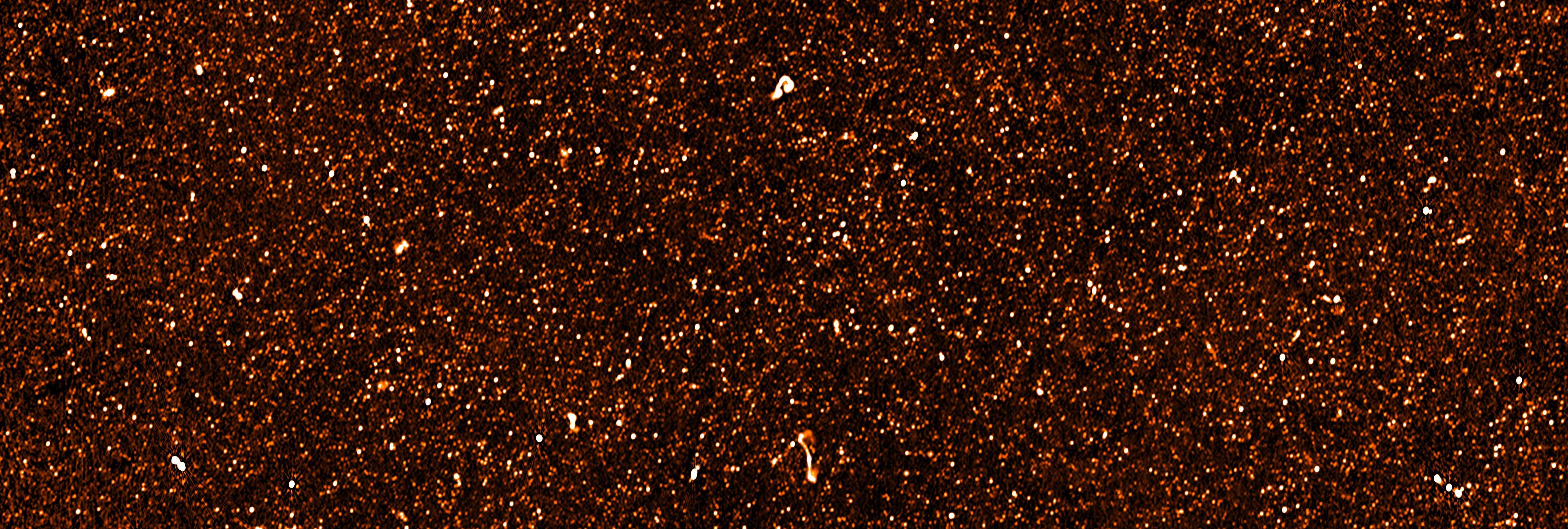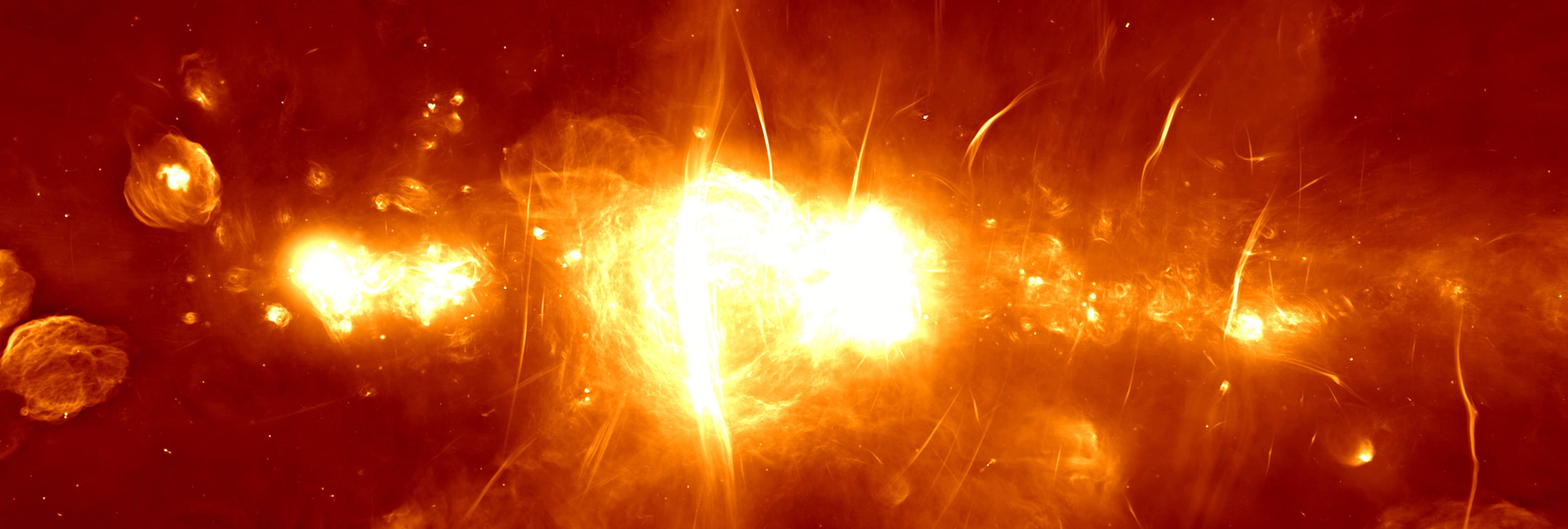MeerKAT
MeerKAT is a connected array of radio telescopes located in the Northern Cape province of South Africa, and is a precursor instrument to the mid-frequency component of the Square Kilometre Array (SKA). The 64 dishes are 13.5 m in diameter, with maximum separations of 8 km. The received signals travel to a subterranean processor building that combines them and allows the telescopes to work together as a single instrument.
The extremely high instantaneous sensitivity, wide field of view, and unprecedented imaging capabilities, make MeerKAT a uniquely powerful radio survey telescope. These capabilities are reflected in the data rates associated with the machine, with digitised signals from the dishes entering the processor building at a rate of 2.2 terabits per second, and data flowing out of that building and into the hands of astronomers at rates of up to 2.5 terabytes per hour.
Oxford Astrophysics has close and long-standing ties to this project and the South African (radio) astronomy community, and we have leading roles in both the commissioning and scientific use of MeerKAT, including several of its flagship Large Survey Projects (LSPs). Our research using MeerKAT ties directly into several of the main research themes of Oxford Astrophysics, and our scientific and technical work is directly informing the corresponding aspects of the SKA.
Galaxy Formation and Evolution
The MIGHTEE survey (Jarvis et al., 2016) is using MeerKAT’s L-band (900 - 1670 MHz) to map four extragalactic deep fields totalling 20 square degrees down to 2 μJy / beam. The survey uses this unique combination of depth and area to study the evolution of galaxies over cosmic time via simultaneous measurements of total intensity and polarised radio continuum, as well as the 21 cm neutral hydrogen (HI; Maddox et al., 2021) and 18 cm hydroxyl (OH) maser lines. The radio observations will be sensitive to Milky Way-like galaxies at z ~ 4, as well as active galactic nuclei and starbursting galaxies out to the cosmic reionization epoch at z ~ 7.
The survey fields (COSMOS, E-CDFS, ELAIS-S1, and XMM-LSS) are also the targets for many deep observations with current and forthcoming ground and space-based facilities. We are also involved in the MeerKAT LADUMA Large Survey Project (Baker et al., 2018) which is an ultra-deep single pointing in E-CDFS. LADUMA is using the L-band and UHF (580 - 1015 MHz) receivers with the principal goal of detecting HI in emission out to z ~ 1.4, either directly or via statistical (stacking) techniques.

The above image shows a small section of the MIGHTEE total intensity mosaic in COSMOS, spanning about 1.5 degrees (Heywood et al., 2021). Routinely achieving noise-limited (or confusion limited) radio images over large areas is a significant challenge, due to both the data volumes and the presence of direction-dependent effects. To meet this challenge we have developed a containerised imaging pipeline for MIGHTEE (Heywood 2020) that is also being used for some components of ThunderKAT (see below), as well as numerous other smaller scale MeerKAT projects.
Pulsars
MeerKAT’s high sensitivity and broad bandwidth make it an extremely powerful telescope to conduct timing of, and searches for radio pulsars, and use them to study many aspects of fundamental physics and astrophysics. The Thousand Pulsar Array (TPA) program (Johnston et al., 2020), part of the MeerTIME LSP (Bailes et al., 2016), is obtaining high fidelity timing measurements of over 1000 pulsars over a 5 year observing program. The main scientific goals are to determine: where the radio emission arises in the magnetosphere, as well as the connection between the magnetosphere and the neutron star itself; pulsar geometries; the use of radio pulsars as a probe of the interstellar medium. The observations use a tied-array beam in full polarisation, allowing for Faraday rotation measures of the targets.

The figure above shows the frequency coverage (vertical axis, higher frequencies at the top) against pulse phase (horizontal axis) for five TPA targets. The high sensitivity data show numerous features including scintillation-induced frequency structure (J0211-8159), inter-pulse emission (J0627+0706), and complex pulse profile structure (J0738-4042).
Transients and Relativistic Astrophysics
The ThunderKAT survey (Fender et al., 2016) uses MeerKAT imaging on a range of timescales to discover, monitor, and understand variable radio sources that are associated with high-energy astrophysical processes. The survey targets a broad range of astrophysical systems, including relativistic X-ray binaries, supernovae, gamma ray bursts and cataclysmic variables.
The key to ThunderKAT is the high instantaneous sensitivity and excellent snapshot imaging capabilities of MeerKAT. This allows regular monitoring of known sources and rapid follow-up of reported transients using modest amounts of telescope time for each observation. ThunderKAT will also conduct commensal searches in LSPs that image the same field multiple times (e.g. MIGHTEE and LADUMA) in order to characterise any variable radio sources that are serendipitously detected in the wide field of view that MeerKAT offers.

The image above shows a small region from four of the weekly ten-minute snapshot observations of the Galactic X-ray binary GX 339-4. Flaring of the binary itself is seen, as well as variability in the radio emission from the intermittent pulsar J1703-4902.
The Galactic Centre
Our involvement in the commissioning of MeerKAT, and the processing of the very first observations from the full 64-dish array, led to the production of the groundbreaking radio image of the Galactic Centre. The image was synthesised from 20 pointings and approximately 200 hours of telescope time, and combined with single dish data from The 100 m Robert C. Byrd Green Bank Telescope to produce the image below. This formed the centrepiece of the telescope's inauguration ceremony in 2018, and generated significant media interest worldwide.

Many intriguing features are visible on many angular scales in this image, which spans about 2.5 degrees. Supernova shells, star forming regions and magnetised radio filaments are visible. The saturated area in the centre is the home of Sagittarius A*, the 4-million solar mass supermassive black hole that resides at the centre of our Galaxy. Further imaging of these observations revealed a pair of huge bipolar radio bubbles spanning 1400 light years, providing evidence for an energetic explosive event in the centre of our Galaxy several million years ago (Heywood et al., 2019).
